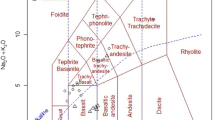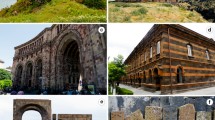Abstract
The research was conducted to verify two vesicular basalt deposits identified for pozzolanic sources. These are Wejerat site, in southern Tigray, which has been the major source of vesicular basalt for cement production, and Adisherafo site found near Hagerselam, central Tigray. Rock samples were collected from both sites to undergo major oxides analysis, possolanacity tests and compressive strength measurements of 2 and 28 days, as well as mineralogical examinations on polished surfaces and thin sections. Field surveys and sample observations revealed the presence of varieties of vesicular, scoriaceous, doleritic, porphyritic and Aphanitic basalts, in decreasing order of vesicularity. The Adisherafo site has dominantly vesicular basalt intermingled with intravolcanic diatomite units. The Wejerat vesicular basalts are best fit for pozzolan source with mean 2 and 28 days compressive strength of 14.9 and 34.0 MPa, exceeding the minimum limits of 10.0 and 32.5 MPa, respectively. Their mean [OH-] and [CaO] values in the pozzolanicity test are 43.0 and 11.4 mmol/l, respectively, falling on the pozzolanic area of the Frattini curve. Dolerite samples turned out to be promising sources in all tests. The scoriaceous as well as Adisherafo’s vesicular basalt and diatomite units show marginal pozzolanic characteristics. The total sum of oxides (SiO2 + Al2O3 + Fe2O3) minimum 70%, is met with samples from all but the weathered basalt unit. The research has indicated the effect of the texture and mineral constituents on the pozzolanic charactertics of volcanic rocks as well as the importance of relying on more methods than conventional ones to characterize pozzolanic materials.







Similar content being viewed by others
References
Alp İ, Deveci H, Süngün YH, Yilmaz AO, Kesimal A, Yilmaz E (2009) Possolanic characteristics of a natural raw material for use in blended cements. Iran J Sci Technol Trans B Eng 33:291–300
Al Naaymi TA (2015) Assessment of pumice and scoria deposits in Dhamar -Rada’ volcanic field SW- Yemen, as a pozzolanic materials and lightweight aggregates. Int J Innovative Sci Eng Technol 2:386–402
ASTM C 618 (2003) Standard speciation for coal fly ash and raw or calcined natural pozzolan for use in concrete. American Society for Testing and Materials, ASTM International, West Conshohocken
Baker J, Snee L, Menzies M (1996) A brief Oligocene period of flood volcanism in Yemen: implications for the duration and rate of continental flood volcanism at the afro-Arabian triple junction. Earth Planet Sci Lett 138:39–55
Beyth M (1972) The geology of central and western Tigray. Unpublished doctoral dissertation, Rheinische Friedrich-Wilhelms Universität, Bonn, Germany, p. 200
Bheemalingeswara K, Nata T (2009) Petrographic and geochemical study of low grade metamorphic rocks around Negash with reference to base metal mineralization and groundwater quality, Tigray, northern Ethiopia. MEJS 1:106–132
Bossellini A, Russo A, Fantozzi PL, Getaneh A, Solomon T (1997) The Mesozoic succession of the Mekele outlier (Tigre Province, Ethiopia). Mem Sci Geol 49:95–116
Dadu DW (2011) An Assessment of Jos Plateau volcanic deposits as Pozzolans and its effect on blended ordinary Portland cement concrete. Dissertation, Ahmadu Bello University
Dadu DW, Bot PJ, Stanley AM (2015) Assessing the JOS volcanic deposits as potentials supplementary cementitious materials for cement blending. Int J Emerging Technol Adv Eng 5:364–370
Dwivedi VN, Singh NP, Das SS, Singh NB (2006) A new possolanic material for cement industry: bamboo leaf ash. Int J Phys Sci 1:106–111
Ethiopian Standard (2005a) Methods of testing cement Part 1: Determination of strength. Quality and Standards Authority of Ethiopia, ES 1176–1, First Edition
Ethiopian Standard (2005b) Methods of testing cement Part 2: Chemical analysis of cement. Quality and Standards Authority of Ethiopia, ES 1176–2, First Edition
Ethiopian Standard (2005c) Methods of testing cement Part 5: Possolanicity test for possolanic cements. Quality and Standards Authority of Ethiopia, ES 1176–5, First Edition
Ghassan KA, Mouin A, David AY, Lisa AK (2011) The use of natural possolana in concrete as an additive or substitute for cement. U.S. Army Engineer Research and Development Center, Construction Engineering Research Laboratory
Hagos M (2011) Geochemical and petrographic studies of the volcano-tectonic evolution of Northern Afar: Implications for the structural setup of the actively expanding Erta’Ale depression. Dissertation, University of Vienna
Hagos M, Koeberl C, Kabeto K, Koller F (2010) Geology, petrology and geochemistry of the basaltic rocks of the Axum area, northern Ethiopia. In: Ray J, Sen G, Ghosh B (eds) Topics in igneous petrology. Springer, Netherlands, pp 69–93
Hofmann C, Courtillot V, Feraud G, Rochette P, Yirgu G, Ketefo E, Pik R (1997) Timing of the Ethiopian flood basalt event and implications for plume birth and global change. Nature 389:838–841
Kieffer B, Arndt N, Lapierre H, Bastien F, Bosch D, Pecher A, Yirgu G, Ayalew D, Weis D, Jerram DA, Keller F, Meugniot C (2004) Flood and shield basalts from Ethiopia: magmas from the African superswell. J Petrol 45:793–834
Lehua Y, Shuangxi Z, Wenwu D (2015) Properties and pozzolanic reaction degree of tuff in cement–based composite. Adv Concrete Construct 3:71–90
Merla G, Abbate E, Azzaroli A, Bruni P, Canuti P, Fazzuoli M, Sagri M, Tacconi P (1979) Comments to the geological map of Ethiopia and Somalia. Consiglio Nazionale delle Ricerche, Firenze, p. 95
Mertens G, Snellings R, Van Balen K, Bicer-Simsir B, Verlooy P, Elsen J (2009) Possolanic reactions of common natural zeolites with lime and parameters affecting their reactivity. Cem Concr Res 39:233–240
Papadakis VG, Antiohos S, Tsimas S (2002) Supplementary materials in concrete. Part II: a fundamental estimation of the efficiency factor. Cem Concr Res 32:1533–1538
Parhizkar T, Najimi M, Pourkhorshidi AR, Jafarpour F, Hillemeier B, Herr R (2010) Proposing a new approach for qualification of natural possolanas. Trans A: Civil Eng 17:450–456
Siva VHR, Achyuthan H, Santhanam M (2015) Pozzolanic characteristics of young Toba tuff. Research Communications 109:1869–1874
Solomon-Ayeh KA (2010) Opportunity for the increased use of clay possolana- The Brri Experience. Building and Road Research Institute (BRRI) Kumasi, Ghana
Ukstins IA, Renne PR, Wolfenden E, Baker J, Ayalew D, Menzies M (2002) Matching conjugate rifted margins: 40Ar/39Ar chrono-stratigraphy of pre- and syn-rift bimodal flood volcanism in Ethiopia and Yemen. Earth Planet Sci Lett 198:289–306
Wafa M, Thameur M, Basma S, Med Jamel R (2012) Effects of the secondary minerals on the possolanic activity of calcined clay: case of quartz. IJRRAS 12:61–71
Yu L, Zhou S, Ou H (2015) Determining the pozzolanic activity component of volcanic rock. Mater Res Innov 19:881–888
Acknowledgements
Mekelle University, College of Natural and Computational Sciences (CNCS) is to be acknowledged for financing this research project. We would like to extend our gratitude to NORAD office for providing vehicle millage service for field works. Mr. Getachew Assefa, duty manager of Messebo cement factory, Mr. Aberra and Mr. Temesgen G/Amlak from quality control department of the factory are thanked for facilitating physical and chemical laboratory analysis. Management staff of the mining department should be appreciated for assisting the fieldwork data collection, secondary data provision as well as expressing interest for further scaling up the research.
Author information
Authors and Affiliations
Corresponding author
Rights and permissions
About this article
Cite this article
Estifanos, S., Abay, A., Hagos, M. et al. Assessing the aptitude of vesicular volcanic rocks as pozzolanic sources for supplementary cementitious materials. Bull Eng Geol Environ 78, 1607–1616 (2019). https://doi.org/10.1007/s10064-018-1239-0
Received:
Accepted:
Published:
Issue Date:
DOI: https://doi.org/10.1007/s10064-018-1239-0




